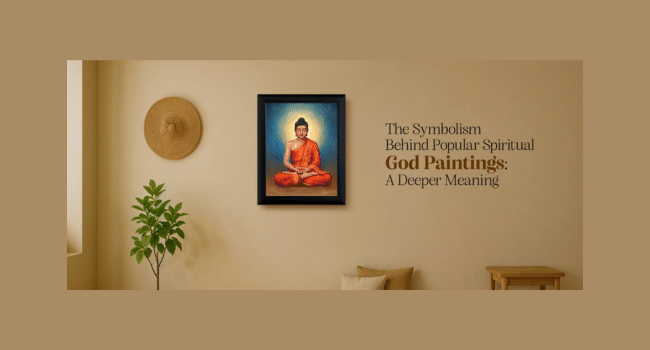Table of Contents
It is common to find a spiritual God painting when visiting an Indian home. This is because Indians have a long legacy and intricate culture rooted in the worship of religious deities.
Indians find inspiration and make daily offerings and prayers to various Gods and Goddesses of different faiths from Hinduism to Buddhism and many more. However, some spiritual artworks depicting commonly worshipped and revered Gods and Goddesses can be found in most Indian homes.
Let us explore the meaning and significance inherent in these popular spiritual God paintings.
Lord Shiva – The Deity of Time
One of the most revered deities in India, Lord Shiva is the subject of various spiritual artworks used to decorate many Indian Homes. His iconic image depicts Him holding a trident and a drum. Lord Shiva represents the continuous cycle of birth, death, and rebirth.
Here are some more interesting facts about the symbolism behind paintings of Lord Shiva –
- The trident with which the deity is depicted represents the Gunas of nature, and the drum in His hand represents the universe’s pulse.
- The Ganga river flowing from the deity’s head represents the stream of knowledge.
- The Vasuki snake coiled around the deity’s neck represents His conquest over crude passion and desires.
- Lord Shiva dons a tiger skin, which represents his victory over all animal instincts.
Goddess Kali – The Icon of Fearless Justice
Goddess Kali is also one of the most highly revered deities in Indian culture. The Goddess features frequently in artworks across different regional cultures in India, a familiar image worshipped in several homes.
The Goddess is depicted with a fierce, bold expression with a protruding tongue and four arms. She holds weapons like a sword in her hands along with a severed head.
Let us see the deep spiritual meaning that lies behind spiritual artworks depicting Goddess Kali–
- The Goddess represents the source of fearless and powerful femininity, a bold dispenser of justice who punishes those who commit wrongs, with death.
- On a deeper level, the Goddess can also be seen to represent the destruction of ego and the attainment of the ultimate truth.
- The sword in the deity’s hand is a symbol of the power to cut through ignorance to achieve truth, and her weapons represent the power to destroy evil and negative forces.
- Goddess Kali’s fierce and destructive image represents a fearless confrontation of truth and the willingness to drive out evil forces.
- The deity teaches us to achieve spiritual liberation by battling our inner demons.
Lord Ganesha – The Bringer of Positivity and Prosperity
Lord Ganesha is another of the deities worshipped in different regional cultures of India with great reverence. As a bringer of positivity and prosperity, Lord Ganesha finds His way into the interior of several homes, featuring in spiritual artworks.
Let us see the deep spiritual significance behind soulful paintings portraying the divine essence of Lord Ganesha
- The deity represents the power to remove obstacles in life that hinder material and spiritual success. This is why the deity is worshipped before people start any new venture or endeavour.
- The bowl of sweets held in the deity’s hand represents the sweetness of the rewards achieved out of hard work or the success achieved as a result of it.
- Thus, the deity is a constant reminder for us to believe in our consistent efforts that can help us get closer to success and the importance of positivity for a happy and prosperous life.
Goddess Lakshmi – The Harbinger of Abundance
Spiritual artworks depicting Goddess Lakshmi represent the deity as a symbol of wealth, abundance and prosperity. The Goddess is most commonly depicted with four arms, holding a lotus in one, and a pot of gold in another.
Let us see what significance is held behind a spiritual God painting representing Goddess Lakshmi –
- The lotus in the deity’s hand represents beauty, purity and spirituality.
- The four arms of the deity hold objects that symbolise the four goals in human life – righteousness, material prosperity, pleasure and spiritual liberation.
- The pot of gold in the deity’s hand represents material abundance that comes out of hard work and perseverance.
Lord Buddha – The Icon of Enlightenment
Images of Lord Buddha are found in thousands of homes across India. He represents enlightenment, peace and inner calm.
The Lord is often depicted while being seated in meditative postures, with specific hand gestures called mudras which convey different spiritual concepts.
Let us see how spiritual artworks depicting Lord Buddha signify deep moral and religious messages –
- The lotus on which the deity is seated represents purity and spiritual growth.
- Different mudras of the deity convey specific meanings like fearlessness and compassion.
- The serene, meditative expression of the deity represents inner calm and wisdom.
Spiritual artworks depicting different Gods and Goddesses worshipped in Indian cultures are more than mere visual depictions. All of these artworks hold deep spiritual significance, often endorsing spiritual values.
Some common and popular spiritual artworks are those depicting Lord Shiva, Goddess Kali, Goddess Lakshmi, Lord Ganesha and Lord Buddha. All of them endorse positive spiritual and moral values and hold a long legacy within religion in India.
